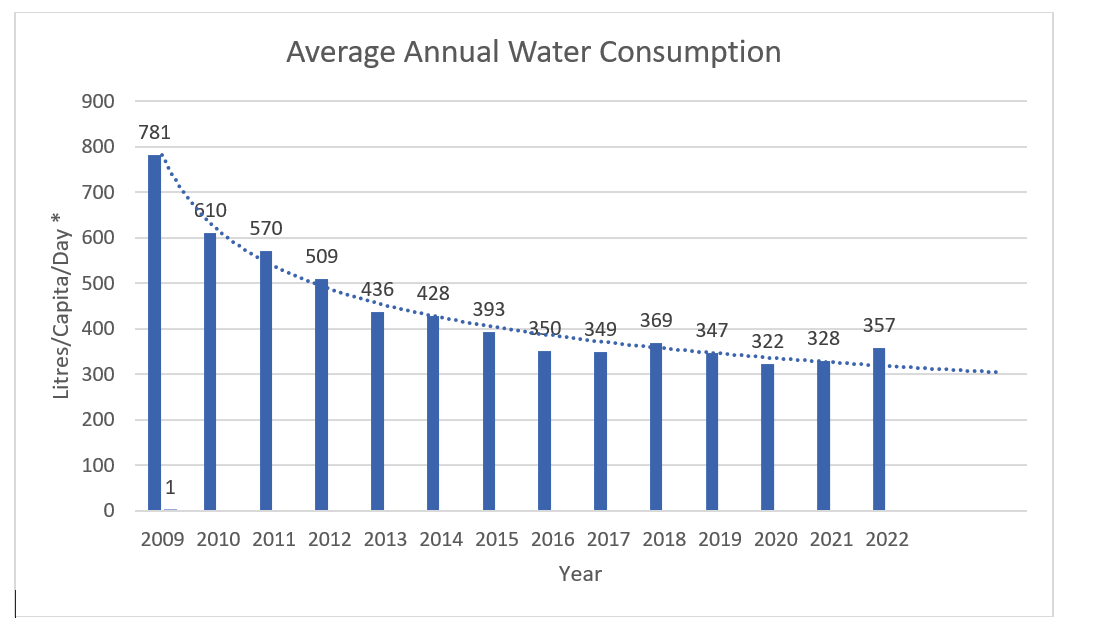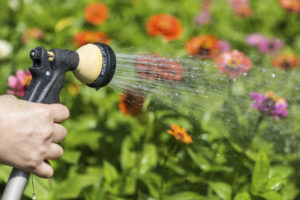Why Conserve Water?
While our system can adequately meet our daily demands, water conservation is important to for a number of reasons.
For the Environment
Water conservation is vital for protecting our aquifer and maintaining a healthy ecosystem. By reducing our water usage, we alleviate pressure on the system, safeguarding natural habitats and biodiversity for generations to come.
For our Community
As License holders and co-stewards of Aquifer 560, it’s our responsibility to conserve water for the well-being of our community. By conserving now, we ensure there’s enough water readily available to meet our needs at homes and businesses and for essential services like fire protection.
We conserve water as a preventative measure, not necessarily in response to a current shortage of water. Our water source is out of sight and the impacts of increased use are not as evident as with surface water.
For the Economy
Every drop counts not just for the environment but also for our town’s finances. By limiting our water usage, we avoid costly upgrades to our water infrastructure and stay within the limits of our water license, saving valuable financial resources.
Water pipes, reservoirs, pumps and other parts of the Town’s water distribution system must be sized appropriately for the Maximum Daily Demand. What’s that? It is the day or days that have the highest water use, usually during the summer months. If we reduce the Maximum Daily Demand through conservation we also reduce the required size of various components of our water system. If we can use smaller components that cost less, we save money.
As an example, the size of the newest reservoir would have needed to be approximately 50% larger at a cost of around $500,000 if the Town was still using the same amount of water each day that we used in 2008. Thanks to conservation efforts of both the residents and the Town, we dropped our ‘per capita’ usage by more than 50% between 2008 and 2018, including the conservation realized by the installation of water meters. (see chart below.)
Gibsons water users have made great strides at reducing our water use over the last few years. Let’s keep it up!
The Benefits of Water Meters

Water Conservation Tips
-
- Keep a pitcher of water in the refrigerator or use ice cubes to cool water. Running the tap to cool water for drinking loses 12 litres per minute.
- Boil just the amount of water in the kettle that you need when making coffee or tea. Don’t overfill it then throw the extra water down the drain.
- Save water when cleaning vegetables by rinsing them in a sink or bowl filled with clean water. Running the tap to rinse vegetables loses 12 litres of water per minute.
- To get the most out of every wash cycle only turn on dishwashers and clothes washers when they are full. Consider washing the dishes by hand and getting in a visit with your family.
- Turn the tap off when brushing your teeth or shaving. Before brushing, wet your brush, and fill a tumbler to rinse your mouth. Savings: 12 litres per minute.
- A five-minute shower with a standard showerhead uses 100 L of water. A five-minute shower with a high efficiency showerhead uses 35 L of water. Turn off the flow while soaping or shampooing. Cutting your shower by 1-2 minutes can save 2,600 litres of water each month.
- Only partially fill your bathtub for baths.
- Install low-flow aerators in your faucets and reduce the flow rate dramatically. Many of the new taps on the market already have aerators installed.
- Replace conventional toilets with low-flow or high-efficiency toilets. They use only 3-6 litres per flush instead of 18 litres, saving a lot of water!
- To preserve water quality and the environment, avoid using harsh chemical cleaners; instead, try friendly alternatives such as vinegar or baking soda.
- Check for leaks around taps, pipes and toilets. To check your toilet for leaks, put a little food colouring in the tank. If it appears in the bowl without flushing, you have a leak. Leaks can waste 14% of all the water we use in our home.
OUTDOORS:
- Collect rainwater for watering the garden by using a rain barrel or rain harvesting system.
- Water roots rather than leaves using a drip irrigation system, or water by hand.
- If you do water trees, this should be done slowly, deeply and infrequently. This encourages deep roots, making your tree healthier and helps save water.
- Don’t water plants if rain is expected in the forecast. Giving plants too much water creates shallow roots that are more susceptible to drought.
- Plant drought-resistant trees and plants. Many native plants can survive on rainwater alone. Practice xeriscaping or look for plants with the low water use sticker.
- Avoid watering on windy/hot days as much of the water is lost to evaporation.
- Use an automatic timer to regulate the amount/duration of the watering.
- Adding a few inches of mulch to your gardens keeps your plants’ roots cool and moist. Organic mulches (e.g. grass clippings) also release nutrients back into the soil.
- When mowing the lawn, use a higher setting on your lawn mower as longer blades of grass shade the soil and reduce stress on the plant.
- Take the bag off the mower – grass clippings are 90% water. Given a bit of time, they work their way back into the soil providing valuable nutrients and more importantly, water to the lawn.
- A lawn can be dormant (brown) for weeks with minimal to no watering. It is part of the grass’s natural cycle.
- During the summer, about half of all potable water is sprayed onto lawns and gardens.
- Check hoses/taps for leaks frequently. A tap leaking one drop of water per second wastes more than 25 L of water a day! That’s 9,000 L a year!
- Get sprinklers with regulators to prevent inefficient misting.
- If you do sprinkle your lawn, be sure to do it in the early morning or evening to reduce evaporation by up to 75%. It also achieves greater soil saturation and provides better absorption of the water. Watering twice a week for less than an hour should be more than enough. Most plants will thrive with far less water than we currently use. Choose a sprinkler that suits the size/shape of your lawn or garden.
- If you own a pool, be sure to use a pool cover when it’s not in use. This will cut down on evaporation losses, and will keep it cleaner and warmer. Check equipment such as filtration systems and water inlets on a regular basis for signs of leaks.
- Using a broom or rake to sweep sidewalks/driveways instead of using the hose saves about 200L of water…each time!
- Washing the car uses 500 litres of water! Turn the hose off while you swab the car or use products that require no water at all.
- Report leaks in fire hydrants, plumbing, or other public facilities so that they can be repaired.
Click the Daily Water-Saving Tip (below) to link to get 100 more water conservation tips
Did you know?
- With the implementation of water meters average water consumption typically decreases by 15-30%
- In nearly all the world’s major religions, water is attributed with important symbolic and ceremonial properties.
- On average, 35% of household water is used for showers and baths, 30% for toilets, 20% for laundry, 10% for the kitchen and drinking and 5% for cleaning.
- A single lawn sprinkler spraying 19 litres of water per minute uses more water in just one hour than a combination of ten toilet flushes, two 5-minute showers, two dishwasher loads, and a full load of clothes.

